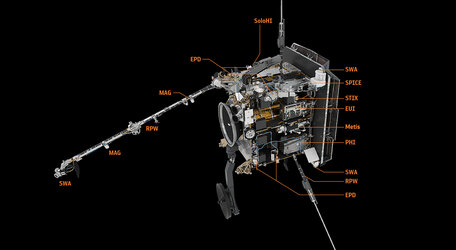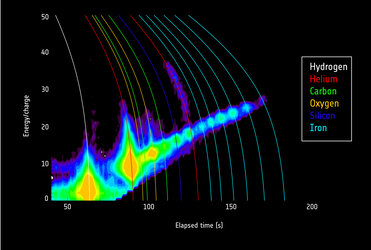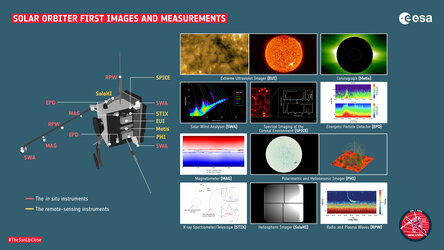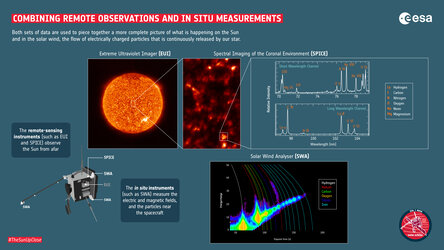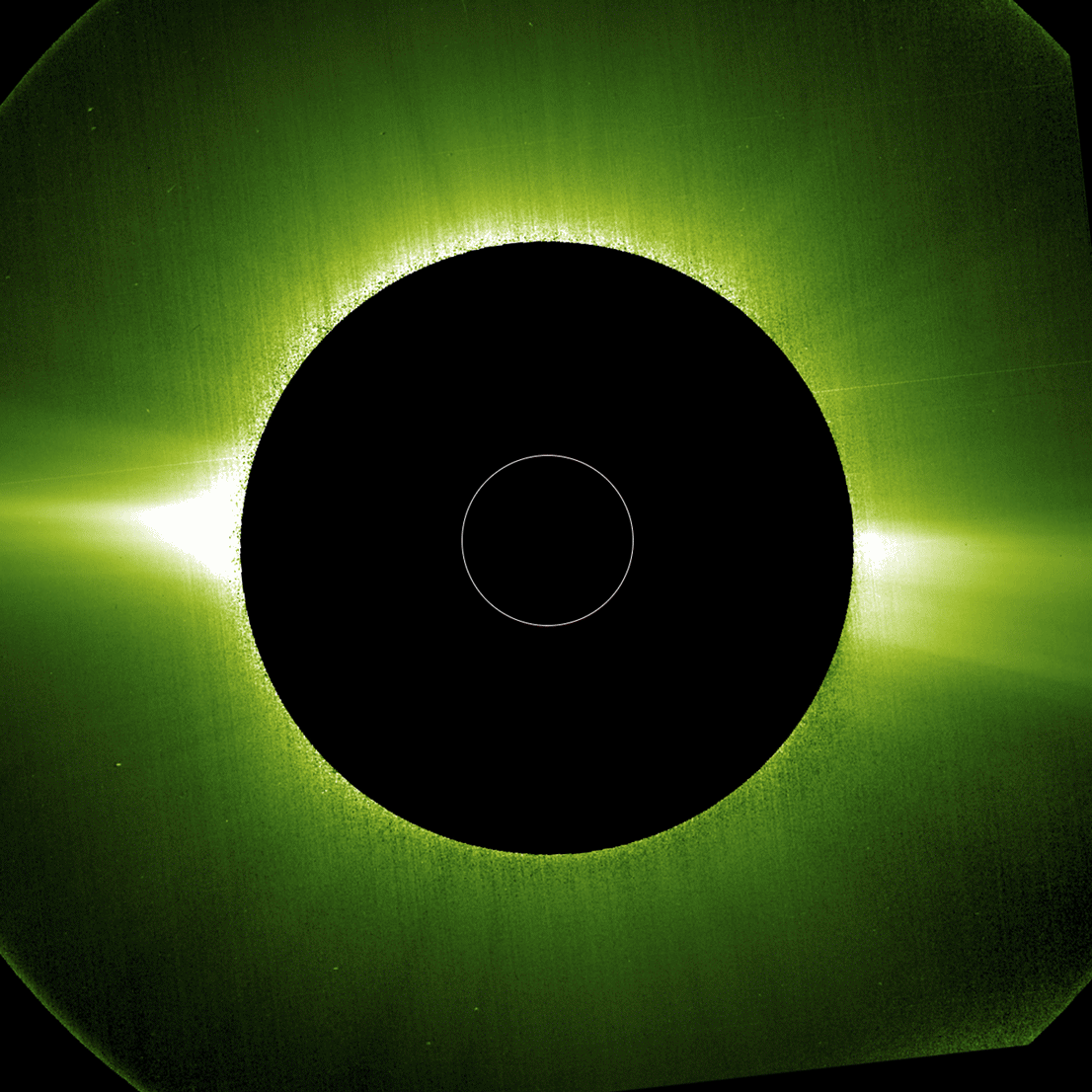

Solar Orbiter's instruments
Solar Orbiter has a suite of ten science instruments to study the Sun. There are two types: in situ and remote sensing. The in situ instruments measure the conditions around the spacecraft itself. The remote-sensing instruments measure what is happening at large distances away. Together, both sets of data can be used to piece together a more complete picture of what is happening in the Sun’s corona and the solar wind. (For more information on the Sun's different layers and activity, click here.)
The in situ instruments:
EPD: Energetic Particle Detector
EPD measures the energetic particles that flow past the spacecraft. It looks at their composition and variation in time. The data helps scientists investigate the sources, acceleration mechanisms, and transport processes of these particles. Principal Investigator: Javier Rodríguez-Pacheco, University of Alcalá, Spain
MAG: Magnetometer
MAG measures the magnetic field around the spacecraft with high precision. It helps determine how the Sun’s magnetic field links to the rest of the Solar System and changes with time. This helps us understand how the corona is heated and how energy is transported in the solar wind. Principal Investigator: Tim Horbury, Imperial College London, United Kingdom
RPW: Radio and Plasma Waves
RPW measures the variation in magnetic and electric fields using a number of sensors and antennas. This helps to determine the characteristics of electromagnetic waves and fields in the solar wind. RPW is the only instrument on Solar Orbiter that makes both in situ and remote sensing measurements. Principal Investigator: Milan Maksimovic, LESIA, Observatoire de Paris, France
SWA: Solar Wind Plasma Analyser
SWA consists of a suite of sensors that measure the solar wind’s bulk properties, such as density, velocity and temperature. It also measures the composition of the solar wind. Principal Investigator: Christopher Owen, Mullard Space Science Laboratory, United Kingdom
The remote-sensing instruments:
EUI: Extreme Ultraviolet Imager
EUI takes images in ultraviolet light, revealing the solar chromosphere, transition region and corona. This allows scientists to investigate the mysterious heating processes that take effect in these regions and will allow connecting in situ measurements of the solar wind back to their source regions on the Sun. Principal Investigator: David Berghmans, Royal Observatory, Belgium
Metis: Coronagraph
Metis takes simultaneous images of the corona in visible and ultraviolet wavelengths. This shows the structure and dynamics of the solar atmosphere in unprecedented detail, stretching out from 1.7 to 4.1 solar radii. This allows scientists to look for the link between the behaviour of these regions and space weather in the inner Solar System. Principal Investigator: Marco Romoli, INAF – University of Florence, Italy
PHI: Polarimetric and Helioseismic Imager
PHI provides high-resolution measurements of the magnetic field across the photosphere, and maps of its brightness at visible wavelengths. It also produces velocity maps of the movement of the photosphere that will allow helioseismic investigations of the solar interior, in particular the convective zone. Principal Investigator: Sami Solanki, Max-Planck-Institut für Sonnensystemforschung, Germany
SoloHI: Heliospheric Imager
SoloHI takes images of the solar wind by capturing the light scattered by electrons particles in the wind. This allows scientists to identify transient disturbances in the solar wind, such as the type that can trigger a coronal mass ejection, in which a billion tons of coronal gas can be ejected outwards into space. Principal Investigator: Russell A. Howard, US Naval Research Laboratory, Washington, D.C., USA
SPICE: Spectral Imaging of the Coronal Environment
SPICE reveals the properties of the solar transition region and corona by measuring the ultraviolet wavelengths given off by the plasma. This data is matched to the solar wind properties that are subsequently detected by the spacecraft’s in situ instruments. European-led facility instrument; Principal Investigator for Operations Phase: Frédéric Auchère, IAS, Orsay, France
STIX: X-ray Spectrometer/Telescope
STIX detects X-ray emission coming from the Sun. This could be from hot plasma, often related to explosive magnetic activity such as solar flares. STIX provides the timing, location, intensity, and energy data for these events so that their effects on the solar wind can be better understood. Principal Investigator: Säm Krucker, FHNW, Windisch, Switzerland
Solar Orbiter is a space mission of international collaboration between ESA and NASA. Its mission is to perform unprecedented close-up observations of the Sun and from high latitudes, providing the first images of the uncharted polar regions of the Sun, and investigating the Sun–Earth connection. Data from the spacecraft’s suite of ten instruments provide unprecedented insight into how our parent star works in terms of the 11-year solar cycle, and how we can better predict periods of stormy space weather.














 Germany
Germany
 Austria
Austria
 Belgium
Belgium
 Denmark
Denmark
 Spain
Spain
 Estonia
Estonia
 Finland
Finland
 France
France
 Greece
Greece
 Hungary
Hungary
 Ireland
Ireland
 Italy
Italy
 Luxembourg
Luxembourg
 Norway
Norway
 The Netherlands
The Netherlands
 Poland
Poland
 Portugal
Portugal
 Czechia
Czechia
 Romania
Romania
 United Kingdom
United Kingdom
 Slovenia
Slovenia
 Sweden
Sweden
 Switzerland
Switzerland

























